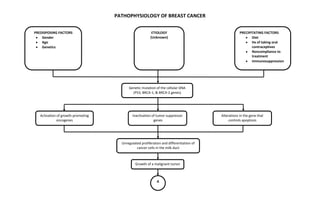
Pathophysiology of breast cancer (2)
- 1. PATHOPHYSIOLOGY OF BREAST CANCER PREDISPOSING FACTORS ETIOLOGY PRECIPITATING FACTORS Gender (Unknown) Diet Age Hx of taking oral Genetics contraceptives Noncompliance to treatment Immunosuppression Genetic mutation of the cellular DNA (P53, BRCA-1, & BRCA-2 genes) Activation of growth-promoting Inactivation of tumor suppressor Alterations in the gene that oncogenes genes controls apoptosis Unregulated proliferation and differentiation of cancer cells in the milk duct Growth of a malignant tumor A
- 2. A Activation of immunologic Release of growth factors mechanism Cancer cells destroy normal RBCs Cancer cells release Angiogenesis Release of B-lymphocytes, exosomes T-lymphocytes & Natural Anemia of Chronic disease Killer cells Impairment of the immune ↓ Lymphocytes response ↓ RBC Pale nail beds Death of some Cancer cells ↓Hgb ↓ Capillary refill Immunosuppression Pneumonia of Release of Neutrophils and Crackles Immunosupression Macrophages Malignant tumor grows rapidly Production of Pyrogenic Productive cough cytokines: (IL-1) DOB C B Fever
- 3. B Change in symmetry or size Rapid multiplication of Malignant tumor obstructs Malignant tumor tends to compress of the breast cancer cells the milk duct blood and lymphatic vessels Rupture of milk duct Rapid metabolism caused by the cancer cells ↓ Blood supply to the breast tissue Inflammatory response Normal cells are deprived of C nutrients Ischemia Release of chemical mediators: Unexplained Bradykinins & Prostaglandins Necrosis weight loss Fatigue Transient vasoconstriction Limited ROM (3/5) F D E G
- 4. D E F G Vasodilation Blood and lymph stasis Cancer cells begin to spread locally via lymphatic vessels ↑Vascular permeability Presence of cancer cells in lymph nodes Plasma fluid leaks into the tissue Palpable, immovable, Swelling Tissue decay hard & painless nodes: Supraclavicular and axillary lymph nodes (2 cm) Compression of the nerve endings Foul odor Pain Accumulation of fluid, cells and cellular debris & live and Pus dead lymphocytes
